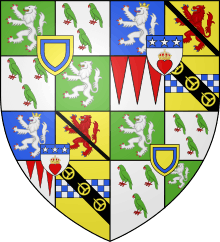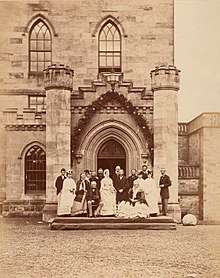Earl of Home
| Earldom of Home | |
|---|---|
  Quarterly: 1st & 4th grandquarters, quarterly: I & IV: vert a lion rampant argent armed and langued gules (Home); II & III: Argent three popinjays vert beaked and membered gules (Pepdie of Dunglas); overall an escutcheon or charged with an orle azure (Landale); 2nd & 3rd grandquarters, quarterly: I: Azure a lion rampant argent armed and langued gules crowned with an imperial crown or (Lordship of Galloway); II: Or a lion rampant gules armed and langued azure debruised of a ribbon sable (Abernethy); III: Argent three piles gules (Lordship of Brechin); IV: or a fess checky azure and argent surmounted of a bend sable charged with three buckles of the field (Stewart of Bonkill); over all on an inescutcheon argent a man's heart gules ensigned with an imperial crown proper and a chief azure charged with three mullets of the field (Douglas) | |
| Peerage | Peerage of Scotland |
| First holder | Alexander Home, 1st Earl of Home |
| Present holder | David Douglas-Home, 15th Earl of Home |
| Subsidiary titles |
Lord Dunglass Lord Home Baron Douglas |
| Seat(s) |
The Hirsel Castlemains |
| Former seat(s) | Douglas Castle, Hume Castle, Fast Castle, Bothwell Castle |

Earl of Home (/ˈhjuːm/ HEWM) is a title in the Peerage of Scotland. It was created in 1605 for Alexander Home of that Ilk, 6th Lord Home. The Earl of Home holds, among others, the subsidiary titles of Lord Home (created 1473), and Lord Dunglass (1605), in the Peerage of Scotland; and Baron Douglas, of Douglas in the County of Lanark (1875) in the Peerage of the United Kingdom. Various Earls of Home have also claimed the title of Lord Hume of Berwick. The Earl is also Chief of the Name and Arms of Home and heir general to the House of Douglas. The title Lord Dunglass is the courtesy title of the eldest son of the Earl.
The most famous recent holder of the title was the 14th Earl, Alexander Frederick Douglas-Home, better known as Sir Alec Douglas-Home. After the unexpected resignation of Harold Macmillan, the 14th Earl was named Prime Minister by the monarch. For the first time in over sixty years, a sitting Prime Minister was a member of the House of Lords rather than of the House of Commons. Because he believed that it was impractical and unconventional to remain a member of the Lords, the Earl disclaimed his peerages on 23 October 1963 under the Peerage Act passed in the same year.[1] He then contested the House of Commons seat of Kinross and Western Perthshire by standing in the Kinross and Western Perthshire by-election, 1963. The seat had been vacated by the death of the previous Member of Parliament, Gilmour Leburn. As of 2017 the titles are held by the 15th Earl, who succeeded in 1995.
The family seats are The Hirsel, near Coldstream, Berwickshire and Castlemains, near Douglas, South Lanarkshire. Former seats include Douglas Castle (demolished) and Bothwell Castle in the care of the state.
Origins
The Earls of Home descend in the male-line from Cospatric I (died after 1074), the Anglo-Danish Earl of Northumbria. His descendant William de Home (son of Sir Patrick de Greenlaw, a younger son of Cospatric I, Earl of Dunbar), adopted the surname following his acquisition of the lands of Home in Berwickshire in the early 13th century through marriage to his cousin Ada (the daughter of Patrick I, Earl of Dunbar).[2] William's arms featured the silver lion of Dunbar but with a green field instead of a red field, in reference to his lands of Greenlaw.[3]
Lords Home (1473)
- Alexander Home, 1st Lord Home (d. 1490)
- Alexander Home, 2nd Lord Home (d. 1506)
- Alexander Home, 3rd Lord Home (d. 1516)
- George Home, 4th Lord Home (d. 1549)
- Alexander Home, 5th Lord Home (d. 1575)
- Alexander Home, 6th Lord Home (c. 1566–1619) (created Earl of Home in 1605)
Earls of Home (1605)
- Alexander Home, 1st Earl of Home (c. 1566–1619)
- James Home, 2nd Earl of Home (d. 1633)
- James Home, 3rd Earl of Home (c. 1615–1666)
- Alexander Home, 4th Earl of Home (d. 1674)
- James Home, 5th Earl of Home (d. 1687)
- Charles Home, 6th Earl of Home (d. 1706)
- Alexander Home, 7th Earl of Home (d. 1720)
- William Home, 8th Earl of Home (d. 1761)
- Alexander Home, 9th Earl of Home (d. 1786)
- Alexander Home, 10th Earl of Home (1769–1841)
- Cospatrick Alexander Home, 11th Earl of Home (1799–1881) (created Baron Douglas in 1875)
- Charles Alexander Douglas-Home, 12th Earl of Home (1834–1918)
- Charles Cospatrick Archibald Douglas-Home, 13th Earl of Home (1873–1951)
- Alexander Frederick Douglas-Home, 14th Earl of Home (1903–1995) (disclaimed 1963) (created Baron Home of the Hirsel in 1974)
- David Alexander Cospatrick Douglas-Home, 15th Earl of Home (b. 1943)
The heir apparent is the present holder's son Michael David Alexander Douglas-Home, Lord Dunglass (b. 1987).
Arms
 |
2nd: On a Cap of Maintenance proper, a Salamander Vert, encircled with flames of Fire proper (Douglas).
|
See also
Notes
- ↑ "No. 43143". The London Gazette. 25 October 1963. p. 8770.
- ↑ Nisbet, Alexander (1816). A System of Heraldry. William Blackwood. p. 270.
- ↑ Nisbet, Alexander (1816). A System of Heraldry. William Blackwood. p. 270.
References
- Mosley, Charles (editor). (1999). Burke's Peerage & Baronetage, 106th edition
- Charles Kidd & David Williamson, editors. (2003). Debrett's Peerage & Baronetage. Macmillan, London , , ,